[Enjoy this Teenage Mutant Ninja Turtles post from guest writer Richard Rosenbaum! – Ed.]
Teenage Mutant Ninja Turtles (TMNT) started as a black-and-white indie comic that lovingly satirized the era’s predominant superhero tropes – teenage mutants (X-Men) and ninjas (Ronin, Daredevil). TMNT’s dominant theme, inherited from postmodern literature in general, is transformation. Typically used to symbolize alienation (think of Kafka’s “The Metamorphosis” or Salman Rushdie’s Satanic Verses), TMNT takes a surprisingly complex tack. It’s actually an exploration and critique of “double consciousness,” the identity theories of philosopher Frantz Fanon, and what it means to be a minority in America.
“Double-consciousness,” coined by W.E.B. Du Bois, is cognitive dissonance from living as a marginalized group, wherein a person identifies, paradoxically, both with his own group and the dominant group oppressing him. Franz Fanon elucidates a similar idea (in Black Faces, White Masks), from a post-colonial perspective. Fanon says “violence is man re-creating himself,” i.e., a marginalized person reclaims his authentic identity through revolution, upsetting dominant social orders.
In TMNT, re-creation of self is symbolized by physical transformation, but attempts to refute Fanon by having heroes be those whose bodies/identities are transformed accidentally or involuntarily. Those who actively transform themselves to upset the power dynamics of the status quo are villains.
The Shredder
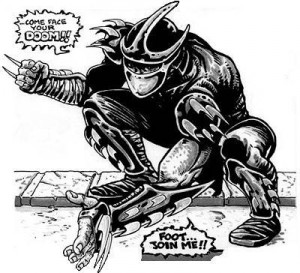
Oroku Saki was a member of the Foot, a Japanese ninja clan. He pursues his enemy, Hamato Yoshi (and Yoshi’s pet rat, Splinter), to New York. After murdering Yoshi, Saki remains in America and builds a U.S.-branch of the Foot, with himself as leader, recasting it as a criminal organization. In an interesting twist on the immigrant narrative, the refugee Yoshi flees to America to escape persecution, but the persecution follows him to finish him off. Saki comes to America for revenge, then, in typical capitalist fashion, realizes he can grab power by starting a Foot Clan “franchise.”
But Saki doesn’t just make himself leader, he forges a whole new identity, cutting off ties with the Japanese Foot and re-creating himself as The Shredder. Shredder is known for wearing head-to-toe metal armour, covered in bladed gauntlets, and concealing nearly his entire face with a mask. This way he attempts to overthrow his original external identity. Hiding his face, he can’t even be identified by his ethnic/national origin, which he’s attempting to transcend. In America, that masked man is simply The Shredder, a figure of power and awe.
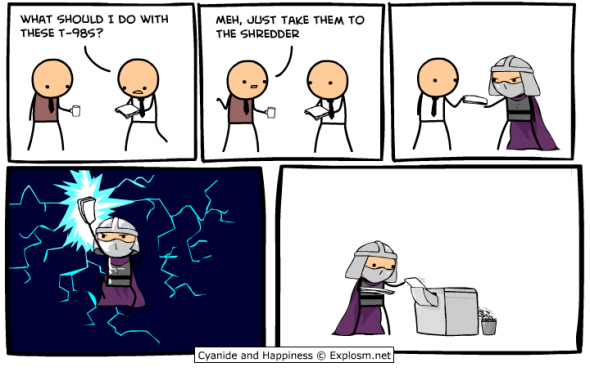
cartoon c/o Cyanide Happiness
Later, Shredder is transformed and re-created even more literally. After his death at the Turtles’ hands (in the comics), the Foot use a combination of ancient mystical wisdom and alien technology to regenerate Shredder from his remains, with memories, personality and skills intact. Here is the ultimate re-invention of the self. Saki literally dies, his body is destroyed and recreated into a form that has only ever been The Shredder.
Baxter Stockman
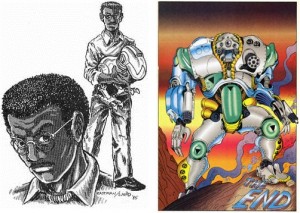
Stockman is a brilliant scientist and robotics engineer, but also a greedy, power-hungry egomaniac. In the original comic he’s African-American, which speaks to the double-consciousness of Du Bois. His race is never referred to, but it’s easy to read Stockman as a genius in a society where black men are stereotypically not “supposed to be” intelligent. His greed overcompensates for this internalized racism. He boasts about his brain-power and uses his robotic creations to steal rather than using his abilities to acquire money legitimately. He publicly subverts American law and capitalism just to show how easy it is for him.
Ultimately, Stockman discards his body completely, building a robot into which he transplants his brain. Like Shredder, Stockman reinvents himself through concealment within metal; he keeps the only part he identifies with (his brain) and throws the rest away.
The cartoon Baxter (portrayed as a stereotypical – and white – mad scientist), also undergoes a transformation, but it’s involuntary. A botched execution mutates him into an anthropomorphic fly. Interestingly, while Baxter-Fly is portrayed as villainous, he’s much more sympathetic than before his transformation. Cartoon-Baxter, never having suffered double-consciousness as a minority as comic-Baxter did, spends the rest of his life trying to become human again, i.e., to reclaim his privileged position as educated, white male.
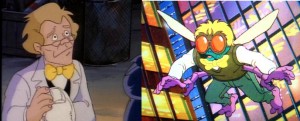
The Turtles and Splinter
In contrast, our heroes the Turtles are transformed organically and involuntarily. The Turtles and Splinter begin their lives in America as ordinary animals but become “humanized” through unintentional exposure to mutagen (i.e., environmental factors). They accept their new identity but did not seek it out. It’s no accident that TMNT takes place in New York City: representative of the melting-pot, immigrant society where disparate identities meld together into a new whole.
The Turtles are unambiguously American heroes. They transcend
- Race (neither black nor white but green);
- Culture (Japanese fighting style / Italian names);
- Species (human/turtle);
- And even planet (they were born in a bucket in the back of a Woolworth’s in Manhattan, but the substance that transformed them was an accidental byproduct of extraterrestrial experimentation)
And though the Turtles and Splinter are marginalized far more than Oroku Saki or Baxter Stockman ever were, they don’t attempt to overthrow society. On the contrary, they fight against those forces that seek to overturn the status quo, forces symbolizing the conscious re-creation of self.
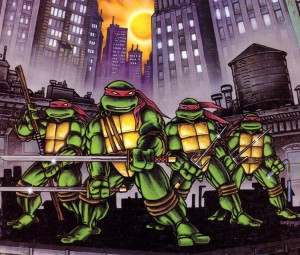
Heroes In A Half Mask
Whereas Fanon advocated that members of marginalized groups reclaim their identity through violent revolution, TMNT characterizes those who remake their identity to upset the social order as villains. Those who uphold the dominant social order are characterized as heroes, even as they are aware that this status quo oppresses them. In TMNT the good guys are those who don’t seek out self-transformation, but accept their hybridized identity.
TMNT shows Fanon’s link between violence and the active re-creation of self as negative. It argues ultimately that manufactured identity is inauthentic, inevitably based upon opposition to some perceived Other, and only leads to destruction. In America (and by extension the globalized world), identity is never a pure element in and of itself, but always a synthesis. Only by accepting the paradoxical confluence of forces that came together to create you do you become a hero.
TMNT says: don’t try to re-create yourself. Just be yourself. Your identity is bound to evolve no matter what. Unlike their enemies The Shredder and Baxter Stockman, the Turtles and Splinter use their unique gifts to work for a just society, not simply one in which they wield the hegemonic power. The Turtles are marginalized, yet they still find the strength to do what’s right. They didn’t choose to be the way they are, but they accept their hybrid identity and make the best of it. At its core, that is the quintessential substance of Turtle Power.
[Have the Ninja Turtles been co-opted by the existing social order to defend its power structures? Or are they reforming it from within? And is Krang a symbol of colonial hegemony? Sound off in the comments! – Ed.]
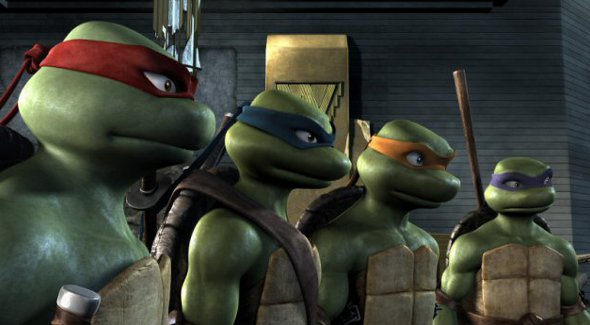
Richard Rosenbaum is Associate Fiction Editor for Incongruous Quarterly and Broken Pencil Magazine, as well as their recently released anthology “Can’tLit: Fearless Fiction from Broken Pencil Magazine.” He just completed his Master’s Degree in Communication and Culture at Ryerson University, and thinks about Ninja Turtles more than is probably healthy.
Awesome piece. Goddamn spot-on. It’s rare to find a reading of a franchise that synthesizes so many disparate elements and fits them all into some totally unexpected structure of meaning. It’s what Overthinking It! tries to do, and what I often try to do in my own blog, and this piece really nailed it.
I always thought it was weird when superheroes who were villainized, demonized and criminalized by society dedicated their lives to protecting it. It feels very white-man wish fulfillment, where we can be as shitty and horrible as we want to the marginalized minority, but they still support us.
Also, what was the deal with Street Sharks? Has there ever been such a blatant ripoff of a cartoon as Street Sharks was of TMNT?
The parallel I usually see to the villianized superhero motif is the work of cops and soldiers, who often see themselves (accurately or not) as sacrificing themselves for a bourgeois society that despises them. See, e.g. Jack Nicholas’ character in “A Few Good Men” (‘You need me on that wall!!’).
But what of the Rat King?
This theme is extremely common in superhero-type fiction, and goes back at least as far as Superman/Lex Luthor.
A less faithful prototype is in the basic “villains are proactive, heroes are reactive” theme. Villains fight because they choose to – they want to attain some evil ends. This event forces the heroes to fight the villain.
Note that batman, who chose his power (at least he did so for a reactive reason), is a bit of an anti-hero.
Grand Unifying theory, anyone?
I like this interpretation. Perhaps Krang is a feudal lord, an old world aristocrat who seeks to impose the power structure he is familiar with on the new world. He routinely fails, because the instruments that allowed for his oppressive hegemony have been rendered obsolete (the technodrome is powered down and he never completely succeeds in re-charging it, despite many attempts). While Shredder tries to force his identity to change, Krang desperately tries to preserve his status in an unfamiliar world. He is thwarted by hybrids that belong to the new order, even though they are too “different” to be accepted (so far) by the mainstream of society.
Excellent post. Bodacious even. I have always liked…cowabunga! (Sorry, I never read the comic TMNT, so the movies and the cartoon [and the 4 person arcade game, with Raphael’s unbeatable roll-kick] are all I know.)
What about Bebop and Rocksteady? Their transformation wasn’t voluntary, and it’d be hard to argue that their animal ‘roots’ are somehow more inherently villainous than turtles or rats. Why do they choose to align themselves with those that “corrupted” their original form?
(Well, I just read the wikipedia page, and apparently they were both originally human gang members that volunteered for ‘enhancement’. So there goes my question.)
But anyway, is the fact that they’re both partially African animals (warthog and rhino) as opposed to ‘American’ animals (turtles and rat) part of a subtle racism in branding them as villains with the primary characteristic of being stupid?
And what’s up with Casey? He’s almost identical to the Shredder, in that he chose to put on a mask and play a role, but since he identifies as an American hero (although a flawed hero, whose hubris costs Mudville the game) he gets to be a good guy?
Here’s a question: why do the turtles wear masks? Are they afraid that when they are out and about in public people might recognise them?
Moreover, the masks help tell them apart (like the weapons they use), so are more identifable, going against what a mask is supposed to do…
lol – great post all around, but this comment was the icing on the cake = )
So having thought of it (for a few seconds at least) my answer is that the TMNT draw a great deal of inspiration from their environment, especially the various media the NYC has to offer – this is evidenced by their language, dietary choices, and general demeanour. Whilst they may have been educated in the ways of the Ninja by a Rat in a sewer, they were likely educated in the ways of the Hero by more (subjectively) rich and varied means. This likely included various caped crusaders who wore masks, Zorro, Green Lantern, the X-Men perhaps, who they naturally emulated if only because they were cool.
Let’s not forget that the TMNT were essentially teenagers, whose identity was unique yet obviously influenced by the times they lived in. Also as teenagers, they likely wanted to be identified as being unique whilst part of the in crowd – having a uniform which identified them as Ninja whilst expressing their personalities seems like a desirable solution for this problem. I doubt that the irony of the situation as you so eloquently expressed entered their minds, except in the case of the long suffering Donatello who went along with it just because that’s what he does.
What I find interesting is the choice of colours. Red for the angry one, Raphael, blue for calm one, Leonardo, with both utilising primary colours. Donatello, for the brainy one who balanced their arguments, a combination of these two colors in a fetching shade of purple. Yet Michaelangelo wore orange, a seemingly appropriate color for the crazy goof ball, a colour which requires yellow to the mix of blue and red. When I think of TMNT, April stands out in her yellow jumpsuit, who liked to explore; cif I’m not mistaken, she and Michaelangelo were rather close, which seems appropriate given her colour completed his these terms.
In contrast to this, Shredder wears grey and is known for his metallic appendage and purple cloak. In Chinese five element theory, metal is an element which overcomes wood by cutting it down, with purple being its associated colour. Green is the colour of wood, like bambo, and is youthful and exeburrent, which seems like a good description of the TMNT – wood consumes water, whose attributes include wisdom, intelligence, and deceptive strength, which seems like a good way to describe Splinter. There’s probably more ways to describe these relationships using the five element theory, though that’s true of just about anything ;)
Wow…well done. It’s nice to not only see someone showing some respect to the original comic, but also holding it up as something more than a parody.
Although, I would have like to see this same philosophy applied to fact that in the book the turtle all wear the same color despite distinctive personalities, weapons and characteristics, but that’s just me :)
Thanks for your comments, everybody. I had a lot of fun writing this thing.
@ToddR
Krang is a really interesting case, actually. He doesn’t exist in the comics, but in the cartoon he’s also been subjected to an involuntary transformation; it’s almost never mentioned but when he was a warlord in Dimension-X, Krang wasn’t the brain-like creature we know but a kind of dinosaur-looking thing with a fully functioning body. When he was exiled to Earth for his crimes, not only was he kicked out of his home (becoming, in effect, a refugee) but he was also physically mutilated, his body reduced to (presumably) some kind of larval state. I guess we have to assume that they don’t have the death penalty in Dimension-X, but the authorities wanted to get Krang as far away and as helpless as possible.
But according to this reading, Krang should be portrayed as a hero, since he was transformed involuntarily. Except that he doesn’t accept his new circumstances; like you said, he “desperately tries to preserve his status in an unfamiliar world.” As a matter of fact, his initial agreement with Shredder was that Shredder would gain access to Krang’s knowledge and technology, and Shredder would arrange to build Krang a new body. Again, a metal body, an android body. One that’s better even than his original, biological one that he lost. We can even think of the Technodrome itself as a kind of pseudo-body with Krang as its, uh, brain. So he’s still seeking to transform himself, thus a villain.
@Mark
Re:Casey, that’s a great point. You’re totally right about the comparison to Shredder: he puts on a mask to create a new identity for himself, with which he goes out and enforces his own rules on society. In the comics, for a long time Casey is a very borderline sort of case – he sometimes can get out of control, though he always stopped short of actually murdering anyone. Casey’s big sort of epiphanic moment is when he uses excessive force with a teenager who tries to mug him, accidentally killing the kid. This is a real wake-up call, and profoundly affects him. For a while he spirals into alcoholism and depression, but finally he realizes basically that it’s the masked persona he’s created that’s taken him over – he even has nightmares about a masked version of himself, all Schwartzeneggered-out, coming after him, trying to kill the “original” Casey and control him completely. He discards the mask, accepts himself, and chills out considerably after that. Presumably at some point Shredder could have made that same choice. That he chose instead to embrace his self-constructed identity and the violence that inherently goes along with it, is why Shredder is a villain but Casey, ultimately, is a hero.
@Jamas Enright & richies^ghost:
The Turtles wearing masks is also an important observation! I REALLY like the five-element interpretation, that’s very very clever. I dig it. I think that we can only interpret the Turtles’ masks as being ironic. Like, whereas Shredder wears a metal mask not strictly just to conceal his identity but cover it up with a new, self-constructed one, let’s look at the Foot Soldiers. They all wear masks too, but they are identical, the point of the ninja mask is to conceal one’s own identity without making the person identifiable at all – the identity of one Foot soldier is basically the same as another. But with the Turtles, their masks clearly don’t do anything to conceal the fact that they’re not regular people. We can contrast their cloth masks with Shredder’s metal one, and we can also say that (in the cartoon, at least) the different colours of the masks serve to actually distinguish the Turtles from each other while not concealing their collective identity either. So their masks fail both as concealers of identity and as a sign of membership in a collective group. In the original comic the masks basically don’t do anything, because they’re all the same colour (red)! So I’ve got to assume that the masks are an ironic shout-out to the ninja tradition. But this issue is pretty complicated, and I haven’t really got it completely figured out.
Thanks again for reading this, everyone!